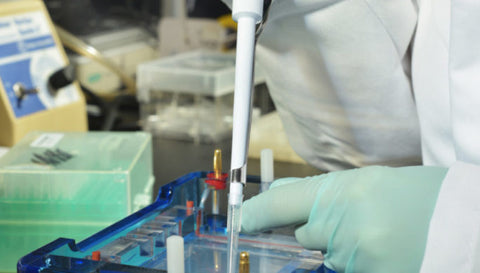pH and Protein Purification

This blog post about pH in the context of protein purification is the third in a series about optimizing conditions for protein purification. Read parts one and two.
Although pH is most commonly seen as an issue in ion-exchange chromatography, it also plays a critical role in affinity tag protein purification. This blog post will discuss why pH is important and how to use appropriate buffer systems to ensure stability.
Why is pH important in affinity purification?
The pH of a solution determines the physical states of the proteins (charge, etc) contained within based on the pKa values of their amino acids. Different proteins have different ranges in which they are stable or will bind to other proteins. The way to keep them stable and active is to use appropriate buffer systems.
The general rule for keeping the protein stable is that the pH of the buffer solution should be within 1.0 pH unit of the protein’s pI, or isoelectric point. pI is the pH at which the protein has no net charge and is determined by the aggregate pKa of every amino acid in a protein. If the pH of the solution = pI of the protein, the protein will be neutral and will aggregate or precipitate.
In addition to the pI of your target protein, knowing the ideal pH ranges of the different components involved in your purification process is crucial to its success. Every affinity resin has a certain range in which a ligand will stably crosslink to the beads and a potentially different range in which a tag will specifically bind to that ligand. For example, in TriAltus’ CL7/Im7 system, the Im7 unit can stably stay crosslinked to the agarose beads between pH 3-10. However, the CL7 tag can only bind between pH 4.2-10. Having an affinity resin and a tag with a wide pH range of stability is helpful because it allows for the purification of proteins with a wider range of pI’s.
What happens if my protein’s pI is outside the pH range of the system I’ve been using?
Problem:
Your lab has been using C-tag successfully for protein purification, which works best in a pH range of 6-8. However, now you’re presented with a protein that has a pI of 9 which falls outside of the system’s optimal range. Short of switching systems, which wastes time and resources, how can you adjust for this mismatch?
Solution:
The solution is to look for different buffers with varying pH ranges that will bring the pH of the solution closer to the range of the pI. In this case, Tris would be helpful as it has a higher pKa. This buffer could be used at pH 8.0, which satisfies both the pH range of the system and is within a pH unit of the target protein. The goal is the balancing act of choosing different buffer systems to stay close to the system’s binding range while staying within 1 pH unit of the pI of the protein.
Other considerations
pH range is also important to note during purification because if proteases are used, they do not cleave as efficiently outside of their optimal range. This is not a deal-breaker but simply may require adding more protease or allowing more time for it to digest. SUMO protease’s range is pH 5.5-9.5 and PSC protease is pH 7-8.
Additionally, purifying proteins using antibodies (immunoaffinity chromatography) is similar to purifying proteins whose affinity tag has a protein ligand. Antibodies bind best at pH 7.0-7.4 and are most commonly eluted at a low pH of 1-3. For the most part, many are stable when using highly acidic elution methods but there is a slight risk of them denaturing.
Knowing the optimal pH ranges of the different elements of your protein purification method is crucial. From resin and tag binding to elution to protease activity, you will be able to use different buffer systems to optimize your purification’s stability and effectiveness.
Read more about pH and the process of protein purification in TriAltus’ protocol.
